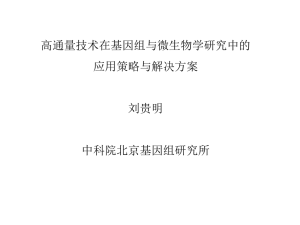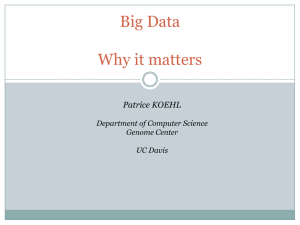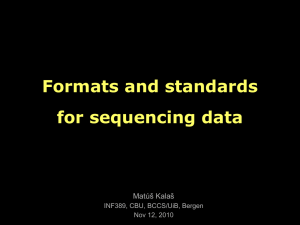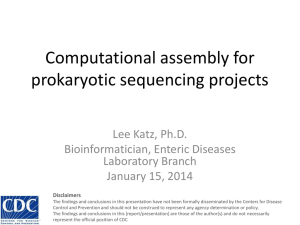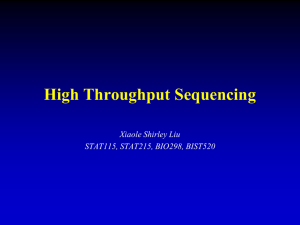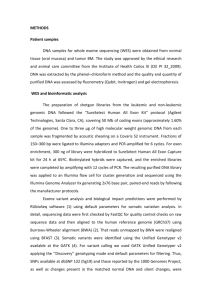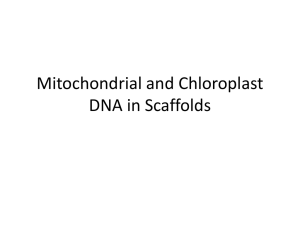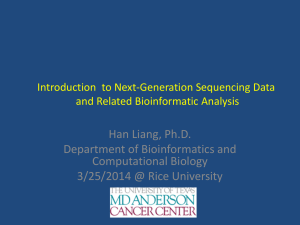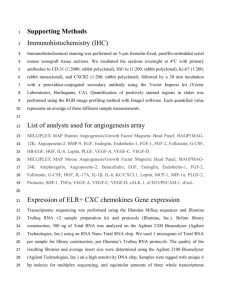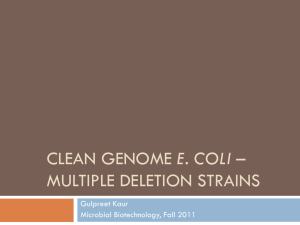Additional file 1
advertisement
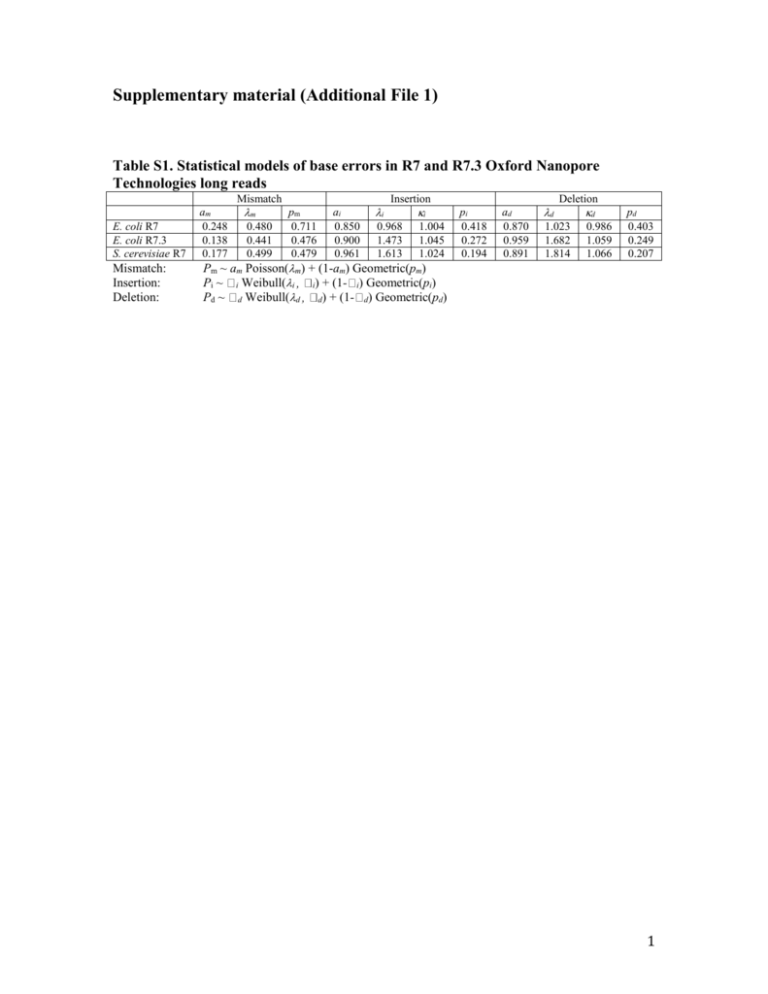
Supplementary material (Additional File 1) Table S1. Statistical models of base errors in R7 and R7.3 Oxford Nanopore Technologies long reads Mismatch E. coli R7 E. coli R7.3 S. cerevisiae R7 Mismatch: Insertion: Deletion: am 0.248 0.138 0.177 m 0.480 0.441 0.499 pm 0.711 0.476 0.479 ai 0.850 0.900 0.961 i Insertion 0.968 1.473 1.613 i 1.004 1.045 1.024 pi 0.418 0.272 0.194 ad 0.870 0.959 0.891 d Deletion 1.023 1.682 1.814 d 0.986 1.059 1.066 pd 0.403 0.249 0.207 Pm ~ am Poisson(m) + (1-am) Geometric(pm) Pi ~ i Weibull(i i) + (1- i) Geometric(pi) Pd ~ d Weibull(d d) + (1- d) Geometric(pd) 1 Figure S1. E. coli K-12 substr. MG1655 genome coverage analysis by Full 2D (R7 chemistry) Oxford Nanopore long reads. High-quality, Full 2D R7 nanopore reads [6] were aligned with blastn [37] onto the E. coli K-12 substr. MG1655 reference (U00096.2), plotting only reads with sequence identity over 50% (1,713 high quality sequences out of 3,471). We identified 184 regions 1 bp and longer with no read coverage. Overall 90.3% of the 4,639,675 bp MG1655 genome was covered by at least one nanopore read. Using a single ONT R7 run [13] provided 3,470 total full 2D reads (21,972,353 bases or 4.7-fold coverage of the E.coli genome). In contrast, Loman and coworkers [26] used four ONT R7.3 runs (ERX708228, ERX708229, ERX708230, ERX708231) for error correction and subsequent assembly. 2 Figure S2. E. coli K-12 Illumina baseline assembly and genome co-linearity. A baseline ABySS assembly (Table 1B in main text) of the E. coli K-12 MG1655 genome yields a draft genome that despite being fragmented is co-linear with the reference. Sequence comparison was performed with MUMmer v3.23 tools, using nucmer for nucleotide sequence alignments and mummerplot for plotting [38]. 3 Figure S3. Full 2D ONT - LINKS scaffolds co-linearity with the MG1655 genome, single k-mer pair LINKS run. A single LINKS scaffolding round (k=15 bp, d=4000 bp) was performed on ABySS assembly sequence scaffolds (shown in Figure. S3B), bringing the number of scaffolds from 61 to 48 (Table 1D in manuscript) and harboring sequences in the correct order and orientation. 4 Figure S4. Full 2D ONT-LINKS scaffolds co-linearity with the reference E. coli K12 genome (thirty k-mer pair interval iterations). Iterative LINKS scaffolding rounds (k=15, d=500 to 16000 bp, 30 iterations) were performed on ABySS assembly sequence scaffolds (Table 1F in manuscript), bringing the number of scaffolds further down to 27 from 61, with its underlying sequences in the exact configuration compared to the reference. 5 Figure S5. LINKS scaffolds using all available R7 2D ONT reads compared to the reference E. coli K-12 genome (thirty k-mer pair interval iterations). Iterative LINKS scaffolding rounds (k=15, d=500 to 16000 bp, 30 iterations) were performed on ABySS assembly sequence scaffolds (Table 1G in manuscript), bringing the number of scaffolds further down to 16 from 61. MUMmer co-linear analysis indicates that six large scaffolds comprise E. coli K-12 MG1655 re-scaffolded sequences in the correct order and orientation. 6 Figure S6. LINKS scaffolds using all raw, uncorrected R7.3 ONT reads compared to the reference E. coli K-12 genome (thirty k-mer pair interval iterations). Iterative LINKS scaffolding rounds (k=15, d=500 to 16000 bp, 30 iterations) were performed on the baseline ABySS assembly sequence scaffolds (Table 1H in manuscript), bringing the number of scaffolds down to 27 from 61. QUAST [24] analysis reveals that rescaffolding with the raw v7.3 ONT data produces an assembly with the best compromise, with fewer errors and highest overall contiguity. 7 Figure S7. LINKS re-scaffolding of a A. thaliana Ler-1 genome draft using raw and ECTools-corrected PacBio long reads. We performed four rounds of iterative LINKS scaffolding of a baseline Allpaths-LG [9,29] assembly (dotted light blue line) using 5 kbp distance increment between k-mers (k=21, t=20|5|5|5, l= 5, a=0.3, d=5-20 kbp, distance step=5 kbp). The scaffolding was done using either raw (bright blue solid line) or ECTools-corrected (+ECT dark blue solid line) PacBio data [18]. We show the contiguity of the assembly, as measured by the NG50 length [23], in relation to both the baseline assembly (Baseline Allpaths-LG assembly, light blue dotted line) and an assembly of the ECTools-corrected PacBio data (ECT assembly, green dotted line). 8 Figure S8. LINKS assemblies of baseline A. thaliana Ler-1 or Ler-0 genome drafts using raw and ECTools-corrected PacBio long reads. Final (4th iteration) LINKS assemblies of baseline Allpaths-LG A. thaliana Ler-1 (blue symbols) or Illumina A. thaliana Ler-0 (orange symbols) assemblies re-scaffolded with raw (19 SMRTcells , square symbols) or ECTools (ECT)-corrected PacBio reads (19 SMRTcells, triangle symbols) were assessed by QUAST using the reference A. thaliana genome (GCA_000001735.1_TAIR10) and compared to other assembly strategies including ECTools (green symbol), PacBioToCA (black symbol) and HGAP (purple symbol). Whereas the HGAP assembly was more than 3x more contiguous than the Allpaths-LG assembly re-scaffolded with LINKS using ECTools corrected reads, as measured by the NG50 length metric, the corrected NGA50 metric (NG50 corrected for errors) is similar between both assemblies. The x,y,z coordinates shown in parentheses represent the number of mis-assemblies, NG50 length (kbp) and NGA50 length (kbp) in this order. 9 Table S2. QUAST analysis of LINKS re-scaffolded A. thaliana Illumina-only assemblies compared to public assemblies of Pacific Biosciences data. Assembly Input librairies Total input bases (genome fold coverage) Reference Genome NA NA ECTools 19 PacBio SMRTcells 4.8 GB (40X, 6X over 10kbp) 74,529 2,029,192 8,341 487,216 PacBioToCA 19 PacBio SMRTcells 4.8 GB (40X, 6X over 10kbp) HGAP Illumina 93 PacBio SMRTcells Illumina MiSeq PE300, 450 bp fragment 93 PacBio SMRTcells 13.8 GB (115X) 14.2 GB (118X) 14.2 GB (118X, 38X over 10kbp) 1,145 12,431,823 6,100,579 8,429,818 Illumina LINKS raw x4 Illumina LINKS ECT x4 AllpathsLG AllpathsLG LINKS Raw x4 AllpathsLG LINKS ECT x4 19 PacBio SMRTcells ECToolscorrected Illumina PE101, 178 bp fragment and PE40, 2 kbp fragment 93 PacBio SMRTcells 19 PacBio SMRTcells, ECToolscorrected 3.4 GB (28X) 13.7 GB (114X) 14.2 GB (118X) 3.4 GB (28X) # contigs 5 49,545 20,530 17,910 17,039 1,705 995 605 Largest contig 30,427,671 1,621,192 651,509 2,070,278 4,071,260 2,930,102 4,799,970 6,895,571 N50 23,459,830 9,986 55,598 436,277 638,133 341,625 1,524,839 2,766,196 NG50 23,459,830 370,686 59,042 492,324 765,370 310,720 1,453,854 2,650,693 # 0 30,088 28,910 8,376 4,675 5,422 5,706 3,463 3,861 4,063 misassemblies # N's per 100 156.28 0.65 4.00 0.00 0.00 1,654.57 4,189.69 1,995.82 3,843.38 5,066.26 kbp Largest 30,263,548 718,881 534,469 724,189 256,783 722,033 721,884 715,300 715,300 715,300 alignment NA50 23,455,979 1,738 2,786 63,573 31,963 56,083 53,974 74,787 82,014 81,658 NGA50 23,455,979 63,635 59,723 87,499 34,519 63,711 63,654 68,118 77,130 78,007 Note: LINKS, Illumina [9] and PacBio assemblies [10,18] were benchmarked against the reference A. thaliana GCA_000001735.1 (TAIR10). ECT: ECToolscorrected PacBio reads. 10 Table S3. Read data used for LINKS scaffolding. Organism E. coli K-12 Sequencing platform Oxford Nanopore S. Typhi H58 Oxford Nanopore S. cerevisiae W303 Oxford Nanopore A. thaliana Ler-0 P. glauca WS77111 Pacific Biosciences Illumina Source http://gigadb.org/data set/100102/ Ecoli_R7_Combined Fasta.tgz http://gigadb.org/data set/100102/ Ecoli_R7_Combined Fasta.tgz https://www.ebi.ac.uk /ena/data/view/ERX7 08228 http://figshare.com/ar ticles/Salmonella_Ty phi_H58_MinION_a nd_Illumina_data/117 0110/ http://schatzlab.cshl.e du/data/nanocorr http://schatzlab.cshl.e du/data/nanocorr http://schatzlab.cshl.e du/data/ectools http://schatzlab.cshl.e du/data/ectools Genbank:JZKD01000 0000 Read type, chemistry Number of Min. Max. Mean N50 Fold reads length Length length length coverage (sequences) (bp) (bp) (bp) (bp) F2D, R7 3,470 356 47,422 6,332 8,113 4.7 2D (F2D+Normal), R7 24,219 233 47,422 6,559 8,442 34.2 Raw, R7.3 66,168 200 94,116 4,701 7,295 67.0 2D 3,738 492 31,630 6,078 7,115 4.7 Raw 249,979 200 146,992 5,805 7,949 119.9 Nanocorr 104,787 200 72,936 4,657 8,296 40.3 Raw 3,448,228 35 41,753 4,137 7,205 118.9 ECToolscorrected Draft genome 288,217 2405 25,609 11,662 12,240 28.0 4,319,880 500 1,347,548 6,357 19,894 ~1.2 *F2D: Full 2D reads, 2D: 2D reads, ECTools-corrected: ECTools-corrected PacBio reads. 11 Table S4. Baseline assemblies used for scaffolding. Organism Genome Data Source Size (Mbp) origin E. coli K-12 4.6 Illumina Illumina BaseSpace, re-sampled to MG1655 241x coverage before ABySS v1.5.2 assembly S. Typhi haplotype 4.8 Illumina Genbank:GCA_000944835.1 H58 S. cerevisiae W303 11.8 Illumina http://schatzlab.cshl.edu/data/nanocorr S. cerevisiae S288c 12.1 Illumina https://www.ebi.ac.uk/ena/data/view/E RR156523, ABySS v1.5.2 assembly A. thaliana 119.1 Illumina http://1001genomes.org/data/MPI/MPI Schneeberger2011/releases/current/Le r-1/Assemblies/Allpaths_LG/ Illumina http://schatzlab.cshl.edu/data/ectools P. glauca PG29 2078.0 Illumina Genbank:ALWZ030000000 12 Supplementary references 37. Altschul SF, Gish W, Miller W, Myers EW, Lipman DJ. Basic local alignment search tool. J Mol Biol. 1990;215:403-10. 38. Kurtz S, Phillippy A, Delcher AL, Smoot M, Shumway M, Antonescu C, Salzberg SL. Versatile and open software for comparing large genomes. Genome Biol. 2004;5:R12. 13
